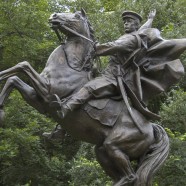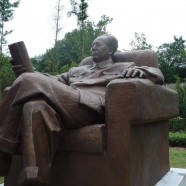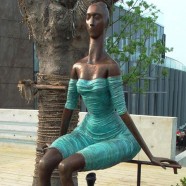The Making of A Bean
Simple shape could make beautiful sculpture. We are very honored to collaborate with sculptor to create a bronze casting. Here is how. Sculpture Name: Bean Size: 6.6 feet long Material: Bronze Production: Sand bronze casting Step One: Digital Modeling. Artist use computer software to create a digital model of the sculpture.The commonly used softwares are like Rhino, Zbrush, Sketchup. Step Two: Sculpture pattern making. The artist send us the digital model he created. We transfer it to the format which is compatible with our CNC milling router, then mill the foam pattern. We do finishing on the milled foam to make it strong enough for sand bronze casting. Step Three: Sand casting. As a a leading fine art foundry in China, we are capable of both sand casting and lost wax casting. For this case, sand casting is more suitable because its surface is smooth and there is no texture on it. One of the benefit of sand casting is that it can minimize the shrinkage of bronze,which commonly happens during bronze casting. Step Four: Patina. We employ hot torching technique for patina, which is capable of making numerous color range for choosing. Feel free to contact us if you have any technical question or need a...
Read MoreFallen: A Man Made Up of Lots of Faces
Recently, Australia sculptor Mr.Ken Sealey designs a sculpture called Fallen, which is a man made up of lots of small flat faces. The sculpture captures the moment when a solider is falling and dying. The sculptor express the scene in a creative way. The sculpture is 45 CM long and cast bronze. Below is a photo of the finished work. As a leading art bronze foundry in China, Tany Foundry is very glad to participate in this project. First, we make the master pattern with advanced Rapid Prototyping technology; then we make silicon rubber mold and wax; finally, we cast the work in bronze with lost wax casting technique, doing finishing and polishing it. Below is a brief description on how Tany Foundry make it. First, the artist sends us the digital model of the sculpture. He sculpt the 3D model with computer software. Besides sculpting directly on computer, 3D model can be also obtained by scanning a real object. This is very useful for realism style sculpture, which is hard to sculpt on computer. The uniqueness of this piece of artworks is its lots of small flat faces, which is difficult to realize in traditional way ( clay working), so the artist make it on computer. Next step, with Rapid Prototyping technology, we make the model of the sculpture. Our next step is making silicon rubber mold and wax work for the sculpture. This is one of the most important step of the whole process. Because of the shape and uniqueness of the sculpture, it requires very high skill to make mold. The faces are flat and the edges are straight, we have to make sure the mold will keep all the details right. To do that, we need to plan the dividing line carefully and disassemble the sculpture into parts. Finally, we cast bronze, doing finishing and polishing on the bronze piece. It looks very beautiful after polishing. If you have any question about the technical process of the sculpture or you need an estimate for your own work. Please contact us. ...
Read MoreIn The Moon- 20 Feet Tall Bronze Monumental Sculpture
As a leading monument bronze foundry in China, Tany Foundry works with two famous Chinese artists Fang Xu and Jieyong Lau on casting a 20 feet tall bronze monumental sculpture: In The Moon. This bronze casting sculpture depicts a girl stretching out her hands under the moon with waves under her foot. The ideas originates from a legend of China and the sculpture is placed in a theming park in middle China. As a leading bronze sculpture foundry in China, we work with artists closely during whole process of the creation of this bronze sculpture. This is the sketch of this work. The composition of the sculpture is great with a nice combination of the body of girl and the curved moon. This is the Marquette of the work. Artist sculpted the girl with clay and we make a fiberglass pattern from it for easier review and keeping. We enlarged the work with clay. After the enlargement work is complete, we make plaster mold for bronze casting. Considering its size and shape, we use sand casting technique to cast bronze, which works best for large scale outdoor sculpture with more emphasis on its whole shape and outline instead of fine details. Technically, a large size bronze sculpture can be sectioned into several separate parts and cast with lost wax technique and then assembly them later. However, the shortcoming of applying lost wax technique on large scale sculpture is that distortion probably happens during the assembling process and this would cause damage to its beauty. By sand casting, we only need to sections the whole body into five parts: head and torso, limbs. This not only saves further assembling work but also make sure the sculpture looks nice. One of the difficulties of the sculpture is design of its armature. Duo the structure of the moon, we have to guarantee the weight of the moon distributed on to the bronze base evenly. Therefore, we weld very solid stainless steel armatures inside for supporting the whole sculpture. Here we are assembling and installing the whole sculpture. Here are some photos of the sculpture In The Moon from different perspective. If you have any question or need a quote from a art foundry. Please contact us. We look forward to your...
Read MoreDream Boat: Copper Sculpture Fabrication
Bronze and copper is often used for sculpture fabrication. Tany Foundry has a team of professional and very experienced artisan. Copper, which is of great extension ability under high temperature, is an excellent material for art fabrication. Before the plastic is invented, copper is one of the most used materials for making everyday utensil: bowl, table, etc. Now plastic and other new material take place of copper but copper successfully find its way into modern art and ornament purpose. Compared with bronze casting, it’s relatively easier to explain how copper fabrication works. To put it simple, fabrication is forming the metal into the desired shape with multiple steps: cutting, welding, bending, finishing, polishing, assembling and other methods. Here is a case of Tany Foundry copper fabrication sculpture. This sculpture is called dream boat which is fabricated with copper, 45 feet long. Overall, the sculpture is made up of two parts, the wave like copper tubes and the curved deck. Here are basic steps how we fabricate it. Fabricate an armature with galvanized steel, which works as a skeleton and support of the whole sculpture. We have to make sure the armature is very strong because whole sculpture weights on it. Prepare copper sheets of 2MM thick and weld them together to the curve required in the drawing and weld them with the armature. Bending copper tubes an welding tubes together to the desired length. This is a very important step in the whole process because the tube shape wave is the major visual feature of this work. The patterns of the wave are carefully designed. We lay the drawing on grounds and shape bronze tubes rigidly following the pattern. Mount the bent copper tubes onto the finished frame. Fix individual bronze tubes together welding and bolts. Finishing and Patina. Here are some pictures of this project. Please let me know if you have any question about the fabrication process. Please click...
Read MoreBronze Cast Sculpture in Varied Patinas
Bronze has been the most often used material for casting sculpture. This is because of the bronze property which could flow and fill all cavity of the mold and therefore reproduce artist’s original work. The so called bronze is actually not pure copper, instead it’s a alloy with a combination of copper and other elements. Silicone, tin and zinc are common element used for forming alloy. Another benefit of using bronze for casting sculpture is its ability to make varied patina. Bronze can react with other chemical easily to represent varies color. The commonly used technique for patina is torching approach and immersion approach, depending on the size of the sculpture. The Torching approach is suitable for middle or large scale sculpture. The first step is to clean the bronze body completely, remove any grease. This is the key step which would make a difference on the final effect. The grease remains would prevent the bronze reacting with the chemicals and leave inconsistent color on sculpture. Then brush and polish the bronze surface. This purpose of this step is not only clean those tiny in and out of the sculpture but also make chemical work with bronze more easily. After that, heat the bronze with torch up, spraying chemical solution onto the bronze. The most used chemical are cupric sulphate, ammonia compounds, etc. The craftsman torch the bronze surface sprayed with chemical solution and make sure the chemical reaction happens. Usually the process would be done a couple of times. There are multiple options for patina. Basically, there are four major color group:Brown; red, green, black. There are quite a few gradual alternatives and combinations of these colors. After reaching the desired patina, the craftsman would brush a thin lay of wax or apply coating onto the bronze sculpture. This could protect the bronze patina last longer. Below are a few of bronze sculptures we patina. If you have any technical question about patina, feel free to contact us....
Read MoreTips to Choose a Fine Art Foundry to Work With
After you spend tons of hours creating a sculpture, the next biggest consideration is to choose an reliable art foundry to cast your works. There are quite a few foundries in Europe, North America. So, how to target an ideal one? One of the best practices is hearing that your friends say. The foundry your friend recommend must get proven his own experience and therefore trustworthy. Another good way is via internet. There are tons of information these days on net: traditional website, social network service such as Facebook, Twitter, etc. One of the biggest advantages of social network is that you can communicate with the people from that foundry before you place an order. Usually, there are rich information you can learn from that foundry’s profile page: you can talk with the foundry about their past work, their casting methods, equipment, price, etc. The more you talk with him, the deeper you know about him. There are several factors you’d better take into consideration: 1. Quality. This is one of the most important factors. It’s easy to test a foundry’s quality by letting them do a small scale sculpture such as a life size bust. Then you can watch closely the casting’s finish, patination and other factors. The test casting is a good method to provide you with information for your further selection. 2. Cost. There are many foundries to choose from and you can compare their offers based their work quality into consideration. Nobody wants their carefully sculpted work riddled with imperfection or other poor finish and patination. You can make a list with potential foundries on it. Those foundries should be able to offer you quality work at a reasonable price. 3. Equipment and Technical process. It’s important to understand that small scale and large scale sculptures required different equipments and process. For small sculpture, foundry often use lost wax technique to cast and for large scale sculpture, they use sand casting. Most of small foundries only have lost wax casting equipment while those medium and large foundries have sand casting equipments. 4. Distance. People tend to work with short distance art foundry because that way they can communicate with the foundry easily and it’s easier for them to keep track of the process. The con of choosing based on distance is that the nearest foundry doesn’t always offer best quality at best price. With the developing logistics and long distance videoing technique ( transfer the picture or video of the process to sculptors lively), lots of sculptors can now work with a distant foundry closely with everything under control. The above are some tips for selecting an ideal art foundry for you. Your ideas or comments are appreciated. If you have any question or comment on how to select an art foundry, please click here....
Read More





